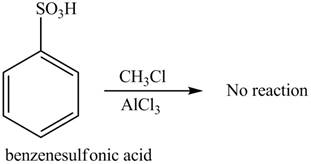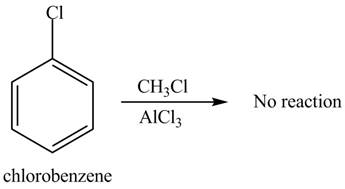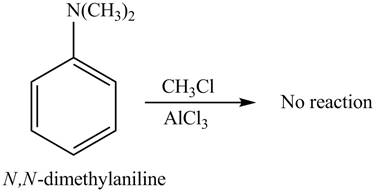
Concept explainers
(a)
Interpretation: The products formed by the Friedel-Craft alkylation of given compound with CH3Cl and AlCl3 are to be drawn.
Concept introduction: The replacement or substitution of one
Answer to Problem 18.21P
The given compound does not undergo Friedel-craft alkylation reaction on reaction with CH3Cl and AlCl3.
Explanation of Solution
The Friedel-craft alkylation of
The structure of given compound shows that benzene ring is substituted by −SO3H group. This group is strong electron withdrawing group. Hence, the Friedel-craft alkylation reaction will not take place on reaction of given compound with CH3Cl and AlCl3.

Figure 1
The given compound does not undergo Friedel-craft alkylation reaction on reaction with CH3Cl and AlCl3.
(b)
Interpretation: The products formed by the Friedel-Craft alkylation of given compound with CH3Cl and AlCl3 are to be drawn.
Concept introduction: The replacement or substitution of one functional group with another different functional group in any chemical reaction is termed as substitution reaction. The electron deficient chemical species that contains positive charge are known as electrophile. In electrophilic aromatic substitution reaction, electrophile takes the position of hydrogen atom by attacking the electron rich carbon atom of benzene.
Answer to Problem 18.21P
The given compound does not undergo Friedel-craft alkylation reaction on reaction with CH3Cl and AlCl3.
Explanation of Solution
The Friedel-craft alkylation of aromatic compound with CH3Cl in presence of AlCl3 involves substitution of CH3 group. Friedel-craft alkylation reaction does not take place when an aromatic ring is substituted by a strong electron releasing or strong electron withdrawing group.
The structure of given compound shows that benzene ring is substituted by −Cl group. This group is a strong deactivating group. Hence, the Friedel-craft alkylation reaction will not take place on reaction of given compound with CH3Cl and AlCl3.

Figure 2
The given compound does not undergo Friedel-craft alkylation reaction on reaction with CH3Cl and AlCl3.
(c)
Interpretation: The products formed by the Friedel-Craft alkylation of given compound with CH3Cl and AlCl3 are to be drawn.
Concept introduction: The replacement or substitution of one functional group with another different functional group in any chemical reaction is termed as substitution reaction. The electron deficient chemical species that contains positive charge are known as electrophile. In electrophilic aromatic substitution reaction, electrophile takes the position of hydrogen atom by attacking the electron rich carbon atom of benzene.
Answer to Problem 18.21P
The given compound does not undergo Friedel-craft alkylation reaction on reaction with CH3Cl and AlCl3.
Explanation of Solution
The Friedel-craft alkylation of aromatic compound with CH3Cl in presence of AlCl3 involves substitution of CH3 group. Friedel-craft alkylation reaction does not take place when an aromatic ring is substituted by a strong electron releasing or strong electron withdrawing group.
The structure of given compound shows that benzene ring is substituted by −N(CH3)2 group. This group is a strong electron releasing group. Hence, the Friedel-craft alkylation reaction will not take place on reaction of given compound with CH3Cl and AlCl3.

Figure 3
The given compound does not undergo Friedel-craft alkylation reaction on reaction with CH3Cl and AlCl3.
(d)
Interpretation: The products formed by the Friedel-Craft alkylation of given compound with CH3Cl and AlCl3 are to be drawn.
Concept introduction: The replacement or substitution of one functional group with another different functional group in any chemical reaction is termed as substitution reaction. The electron deficient chemical species that contains positive charge are known as electrophile. In electrophilic aromatic substitution reaction, electrophile takes the position of hydrogen atom by attacking the electron rich carbon atom of benzene.
Answer to Problem 18.21P
The products formed by the Friedel-Craft alkylation of given compound with CH3Cl and AlCl3 are drawn below.
Explanation of Solution
The Friedel-craft alkylation of aromatic compound with CH3Cl in presence of AlCl3 involves substitution of CH3 group. Friedel-craft alkylation reaction does not take place when an aromatic ring is substituted by a strong electron releasing or strong electron withdrawing group.
The structure of given compound shows that benzene ring is substituted by −NHCOCH3 group. This group is moderately electron releasing group. Hence, the given compound undergoes Friedel-craft alkylation reaction with CH3Cl and AlCl3 as shown in Figure 4.

Figure 4
The products formed by the Friedel-Craft alkylation of given compound with CH3Cl and AlCl3 are shown in Figure 4.
Want to see more full solutions like this?
Chapter 18 Solutions
Package: Loose Leaf for Organic Chemistry with Biological Topics with Connect Access Card
- Q5: Label each chiral carbon in the following molecules as R or S. Make sure the stereocenter to which each of your R/S assignments belong is perfectly clear to the grader. (8pts) R OCH 3 CI H S 2pts for each R/S HO R H !!! I OH CI HN CI R Harrow_forwardCalculate the proton and carbon chemical shifts for this structurearrow_forwardA. B. b. Now consider the two bicyclic molecules A. and B. Note that A. is a dianion and B. is a neutral molecule. One of these molecules is a highly reactive compound first characterized in frozen noble gas matrices, that self-reacts rapidly at temperatures above liquid nitrogen temperature. The other compound was isolated at room temperature in the early 1960s, and is a stable ligand used in organometallic chemistry. Which molecule is the more stable molecule, and why?arrow_forward
- A mixture of C7H12O2, C9H9OCl, biphenyl and acetone was put together in a gas chromatography tube. Please decide from the GC resutls which correspond to the peak for C7,C9 and biphenyl and explain the reasoning based on GC results. Eliminate unnecessary peaks from Gas Chromatography results.arrow_forwardIs the molecule chiral, meso, or achiral? CI .CH3 H₂C CIarrow_forwardPLEASE HELP ! URGENT!arrow_forward
- Identify priority of the substituents: CH3arrow_forwardHow many chiral carbons are in the molecule? OH F CI Brarrow_forwardA mixture of three compounds Phen-A, Acet-B and Rin-C was analyzed using TLC with 1:9 ethanol: hexane as the mobile phase. The TLC plate showed three spots of R, 0.1 and 0.2 and 0.3. Which of the three compounds (Phen-A; Acet-B or Rin-C) would have the highest (Blank 1), middle (Blank 2) and lowest (Blank 3) spot respectively? 0 CH: 0 CH, 0 H.C OH H.CN OH Acet-B Rin-C phen-A A A <arrow_forward
 Organic ChemistryChemistryISBN:9781305580350Author:William H. Brown, Brent L. Iverson, Eric Anslyn, Christopher S. FootePublisher:Cengage Learning
Organic ChemistryChemistryISBN:9781305580350Author:William H. Brown, Brent L. Iverson, Eric Anslyn, Christopher S. FootePublisher:Cengage Learning
